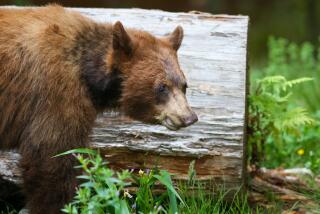4-pound mountain lion cub plucked from Zogg fire with burned paws, singed whiskers
Amid grim news from the Northern California fire zone, one furry sight brought yips of excitement this week when emergency responders rescued a lone mountain lion cub from the burn zone of the Zogg fire in Shasta County.
Despite singed whiskers and burned paws, the blue-eyed cub dubbed Capt. Cal is full of personality and can be seen baring his teeth fiercely in photos.
“He’s doing really well,” said Erin Harrison, vice president of marketing for the Oakland Zoo, where Capt. Cal is being kept. “He’s continuing to eat. He’s getting a little feistier. He’s looking really good.”
When firefighters in Shasta County first spotted the baby, they mistook him for a house cat, said Issac Sanchez, a Cal Fire captain and spokesman. He was wandering alone on Zogg Mine Road before taking refuge under a fallen tree. When the fire crew took a closer look, they realized the animal was a mountain lion kitten.
Officials loaded the baby into a cardboard box and turned him over to the California Department of Fish and Wildlife, which transported him to the Oakland Zoo.
Fish and Wildlife spokeswoman Kirsten Macintyre said that with its facilities and trained staff, the zoo is “uniquely equipped to handle exactly this kind of case.”
At just 4 to 6 weeks old and weighing just under 4 pounds, Capt. Cal is too young and small to return to the wild, Macintyre said. Mountain lions typically stay close to their mothers for two years to learn how to hunt and survive.
Ideal circumstances would allow wild animals to be returned — or kept — in their natural environment, but that isn’t always possible. On Thursday, wildlife biologists announced that an experiment to get a cougar in the Santa Ana Mountains to adopt two orphaned cubs had failed. The effort, which was intended to keep the babies wild, did not work, and the youngsters were placed in a sanctuary.
The foster attempt was undertaken this summer, the Santa Monica Mountains National Recreation Area said.
The zoo is working with UC Davis to give Capt. Cal advanced wound treatment and will keep him until he heals, Harrison said. Chest X-rays showed no lung damage from smoke inhalation. And despite burns to his paw pads, the cub sustained no bone injuries, either.
Once healthy, he’ll go to a new home, such as a sanctuary or another zoo. Two out-of-state organizations have already asked for him, Macintyre said.
“Certainly the best situation would be to be able to return him to the wild,” she said. “But a few can’t, [and] in some cases, the animal can be an ambassador for its species.”
Capt. Cal has already become a household name in California wildfire prevention. The doe-eyed cub’s new moniker ties into Cal Fire’s mountain lion mascot, which the department unveiled last year.
The mascot, a muscly cat in a yellow firefighter jacket, helps spread the message of wildfire preparedness and prevention with his motto: “Safety starts with you.”
Cal Fire spokesman Scott McLean said responders occasionally find wildlife in the course of firefighting.
“Not an overabundance, of course, because they’re smart enough to hightail it out of there,” he said Friday.
Last month, police officers in Lincoln helped rescue a bear that had escaped the coincidentally named Bear fire in Butte County. A biologist tranquilized the 350-pound animal, which walked into a creek and risked drowning, according to the Lincoln Police Department’s Facebook page.
Two officers helped drag the bear, suffering from some scratches, to safety. He is now receiving treatment from California’s Department of Fish and Wildlife, along with another bear from the Zogg fire and a mountain lion from the Bobcat fire, Macintyre said.
Last year, the department housed three bears and a mountain lion from the Thomas and Camp fires. There is no way to gauge how many animals a fire season may be orphans, she said.
“There’s nothing typical about this. All bets are off,” she said. “We’re just kind of at the beginning of the fire season right now, and we’ve already got three in our care. And we expect to get more.”
Nearly 4 million acres have burned in the state in a historic year of firestorms, as crews continue battling roughly two dozen major blazes, including the Zogg fire. That conflagration had burned 56,018 acres as of Friday morning and was 46% contained. The blaze has killed four people and destroyed 159 structures in Shasta County.
More to Read
Sign up for Essential California
The most important California stories and recommendations in your inbox every morning.
You may occasionally receive promotional content from the Los Angeles Times.











